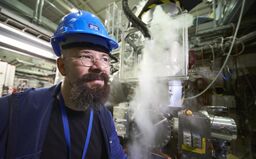Biography:Stefan Ulmer (physicist)
Stefan Ulmer (born 1977 in Tübingen) is a particle physicist, professor of Physics at Heinrich Heine University Düsseldorf and chief scientist at the Ulmer Fundamental Symmetries Laboratory, RIKEN, Tokyo. He is the founder and the spokesperson of the BASE experiment (AD-8) at the Antiproton Decelerator facility at CERN, Geneva. Stefan Ulmer is well known for his contributions to improving Penning trap techniques and precision measurements on antimatter. He is the first person to observe spin transitions with a single trapped proton as well as single spin transitions with a single trapped antiproton, a significant achievement towards a precision measurement of the antiproton magnetic moment.[1][2][3]
Stefan Ulmer completed his Ph.D. thesis from the Heidelberg University, Germany , under the supervision Wolfgang Quint and Klaus Blaum in 2011. Ulmer's studies focused on the first observation of spin flips with a single proton stored in a cryogenic Penning trap.[4][5] In 2012 he was promoted to a PI position at RIKEN, Japan, and in 2019 he became co-director of a MPG, RIKEN, PTB center for time, constants, and fundamental symmetries.
Research
After his Ph.D. studies, Stefan Ulmer joined the ASACUSA CUSP experiment at CERN in 2012 as a postdoctorate fellow, and contributed to the production of the first polarized beam of antihydrogen atoms.[6][5] Simultaneously, he worked on setting up the BASE experiment. He invented a reservoir trap technique that allowed BASE to store antiprotons for about 400 days.[7] In 2014, Stefan Ulmer’s team performed the most precise measurement of the proton-antiproton charge-to-mass ratio, evidently the most accurate test of CPT invariance of baryons.[1][3][8] In 2017, his team reported the first observation of single antiproton spin transitions,[9] and also completed the most precise measurements of antiproton magnetic moment.[10] From a time-base analysis of these data the most stringent limits on dark-matter / antimatter coupling were derived.[11] Inspired by this work, the BASE collaboration has used Penning trap detection systems as axion haloscopes, to set competitive limits on axion-to-photon conversion.[12] In 2022 Ulmer's team reported on a comparison of the proton/antiproton charge-to-mass ratio with a fractional accuracy of 16 parts in a trillion.[13] This measurement also constitutes the first differential test of the clock weak equivalence principle with antiprotons. Ulmer's measurements are considered to be outstanding and of great value for fundamental physics research.[1][3][14]
Awards and recognition
Stefan Ulmer has received the following awards and recognition for his contributions to fundamental experimental physics.
- Falling Walls Award in the Physical Sciences 2022
- He was elected as chairperson and official representative of the antimatter physics community of CERN in 2018.[15]
- International Union of Pure and Applied Physics (IUPAP) young scientist award in fundamental metrology, 2014, for his work on the high-precision comparisons of the fundamental properties of the protons and the antiprotons.[14][16]
References
- ↑ 1.0 1.1 1.2 Symmetries, Max Planck-RIKEN-PTB Center for Time, Constants and Fundamental. "Max Planck-RIKEN-PTB Center for Time, Constants and Fundamental Symmetries - Group of Stefan Ulmer" (in en). https://www.mpi-hd.mpg.de/blaum/mpg-riken-ptb-center/groups/ulmer.en.html.
- ↑ Ulmer, Dr Stefan. "Ulmer Fundamental Symmetries Laboratory". http://ulmerfsl.riken.jp/index.html.
- ↑ 3.0 3.1 3.2 ORCID. "Stefan Ulmer (0000-0002-4185-4147)" (in en). https://orcid.org/0000-0002-4185-4147.
- ↑ Ulmer, Stefan (2011). "First Observation of Spin Flips with a single Proton stored in a cryogenic Penning trap". http://archiv.ub.uni-heidelberg.de/volltextserver/12306/.
- ↑ 5.0 5.1 Yamazaki, Yasunori; Ulmer, Stefan (2013). "CPT symmetry tests with cold and antihydrogen". Annalen der Physik 525 (7): 493–504. doi:10.1002/andp.201300060. ISSN 1521-3889.
- ↑ Kuroda, N.; Ulmer, S.; Murtagh, D. J.; Van Gorp, S.; Nagata, Y.; Diermaier, M.; Federmann, S.; Leali, M. et al. (2015). "The ASACUSA CUSP: an antihydrogen experiment" (in en). Hyperfine Interactions 235 (1–3): 13–20. doi:10.1007/s10751-015-1205-1. ISSN 0304-3843. http://link.springer.com/10.1007/s10751-015-1205-1.
- ↑ Sellner, S; Besirli, M; Bohman, M; Borchert, M J; Harrington, J; Higuchi, T; Mooser, A; Nagahama, H et al. (2017-08-31). "Improved limit on the directly measured antiproton lifetime" (in en). New Journal of Physics 19 (8): 083023. doi:10.1088/1367-2630/aa7e73. ISSN 1367-2630. https://iopscience.iop.org/article/10.1088/1367-2630/aa7e73.
- ↑ Ulmer, Dr Stefan. "Research Topics | Ulmer Fundamental Symmetries Laboratory". http://ulmerfsl.riken.jp/topics.html.
- ↑ Smorra, C.; Mooser, A.; Besirli, M.; Bohman, M.; Borchert, M. J.; Harrington, J.; Higuchi, T.; Nagahama, H. et al. (2017-06-10). "Observation of individual spin quantum transitions of a single antiproton" (in en). Physics Letters B 769: 1–6. doi:10.1016/j.physletb.2017.03.024. ISSN 0370-2693. https://www.sciencedirect.com/science/article/pii/S0370269317302113.
- ↑ Smorra, C.; Sellner, S.; Borchert, M. J.; Harrington, J. A.; Higuchi, T.; Nagahama, H.; Tanaka, T.; Mooser, A. et al. (October 2017). "A parts-per-billion measurement of the antiproton magnetic moment" (in en). Nature 550 (7676): 371–374. doi:10.1038/nature24048. ISSN 1476-4687. PMID 29052625. https://www.nature.com/articles/nature24048.
- ↑ Smorra, C.; Stadnik, Y. V.; Blessing, P. E.; Bohman, M.; Borchert, M. J.; Devlin, J. A.; Erlewein, S.; Harrington, J. A. et al. (November 2019). "Direct limits on the interaction of antiprotons with axion-like dark matter" (in en). Nature 575 (7782): 310–314. doi:10.1038/s41586-019-1727-9. ISSN 1476-4687. https://www.nature.com/articles/s41586-019-1727-9.
- ↑ Devlin, Jack A.; Borchert, Matthias J.; Erlewein, Stefan; Fleck, Markus; Harrington, James A.; Latacz, Barbara; Warncke, Jan; Wursten, Elise et al. (2021-01-25). "Constraints on the Coupling between Axionlike Dark Matter and Photons Using an Antiproton Superconducting Tuned Detection Circuit in a Cryogenic Penning Trap". Physical Review Letters 126 (4): 041301. doi:10.1103/PhysRevLett.126.041301. https://link.aps.org/doi/10.1103/PhysRevLett.126.041301.
- ↑ Borchert, M. J.; Devlin, J. A.; Erlewein, S. R.; Fleck, M.; Harrington, J. A.; Higuchi, T.; Latacz, B. M.; Voelksen, F. et al. (January 2022). "A 16-parts-per-trillion measurement of the antiproton-to-proton charge–mass ratio" (in en). Nature 601 (7891): 53–57. doi:10.1038/s41586-021-04203-w. ISSN 1476-4687. https://www.nature.com/articles/s41586-021-04203-w.
- ↑ 14.0 14.1 iupap (2021-03-05). "C2: Awards - IUPAP: The International Union of Pure and Applied Physics" (in en-US). https://iupap.org/who-we-are/internal-organization/commissions/c2-commission-on-symbols-units-nomenclature-atomic-masses-and-fundamental-constants/c2-awards/.
- ↑ "New chairs for the Antiproton Decelerator Users Community" (in en). https://home.cern/news/news/cern/new-chairs-antiproton-decelerator-users-community.
- ↑ "FLAIR - News" (in en). http://www.flairatfair.co.uk/news.html.
External links
- Ulmer Fundamental Symmetries Laboratory
- Group of Stefan Ulmer, Ulmer Fundamental Symmetries Laboratory, RIKEN, Tokyo
This article needs additional or more specific categories. (August 2021) |
 |



